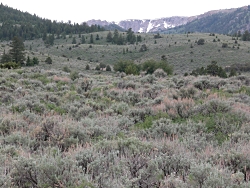
I was always prone to homesickness when I spent long periods in the Eastern US and abroad. Returning to Colorado for visits, I would break off a small branch to pack in my suitcase. That way I could always take some essence of home along with me. Now I don’t need to do that. The desert air and cold winters here in Utah make it a sagebrush heaven.
The scent that has become so dear to me comes from the volatile oils of the sagebrush plant. Ironically, the smell that appeals so much to me repels most animals. The aromatic properties of the sagebrush are a by-product of chemicals that evolved as a pest deterrent and as anti-freeze. Sagebrush oils have a very bitter taste. Browsers, such as deer and elk avoid the plants, nibbling on sagebrush only in winter months when the concentration of oils has decreased. And even then, only as a last resort. The pronghorn– a North American native that co-evolved with sagebrush–can tolerate it better than other herbivores.
Within the sunflower family, sagebrush belongs to the genus Artemisia – a group of wind-pollinated plants spread mostly across the northern hemisphere. The 400 or so species in this genus include a variety of sagebrushes, sageworts, and wormwoods.
The Atlas of Vascular Plants of Utah lists 19 different species in the Artemisia genus. Among the most common, you’ll find sand sagebrush in the dunes and deep sand regions in southern Utah. Black sagebrush is found on gentle, rocky slopes and windswept ridges in dry, shallow soils, in the foothills and desert mountain ranges. Bud sagebrush is common in salt-desert shrub communities from 4-6000 ft. Almost everywhere, however, big sagebrush dominates. It occurs in valleys, basins, and mountain slopes, at elevations between 2,500 and 10,000 feet. In Utah, you’ll also hear the big version called Great Basin, Wyoming or mountain sagebrush.
Humans have put the unique qualities of sagebrush and its relatives to good use. The volatile oils are toxic to many intestinal parasites, therefore early Americans used it to rid themselves of worms. Oils have also been used to combat infections and to treat internal wounds. Eurasian wormwood–an introduced plant in Utah–is the defining ingredient, in the liquor absinthe, and is used for flavoring in other spirits and wines, including bitters and vermouth. The spice tarragon comes from dragonswort, an Artemisa species found in both Eurasia and N. America.
Ecologists used to think that the presence of sagebrush discourages or suppresses other forms of life. Certainly, sagebrush desert steppes are generally poor in species. The truth is that few species can tolerate the temperature extremes, soil conditions and lack of water the way that it can. So the next time you see some, pick a leaf, crush it, smell it, and admire this tough but well-adapted Utah native.
Dr. Leila Shultz, a Utah State University expert on sagebrush provided the science information for this piece.
Thanks to the Rocky Mountain Power Foundation for supporting research and development of Wild About Utah topics.
For Wild About Utah and Stokes Nature Center I’m Holly Strand.
Credits:
Photo Courtesy & Copyright 2007 Dr. Leila Shultz
Text: Stokes Nature Center: Holly Strand
Additional Reading:
Digital Atlas of the Vascular Plants of Utah, https://digitalcommons.usu.edu/wild_facpub/1649/
Shultz, Leila. 2012. Pocket Guide to Sagebrush. PRBO Conservation Science. https://digitalcommons.usu.edu/sagestep_reports/20/
As pdf: https://rdjzr2agvvkijm6n3b66365n-wpengine.netdna-ssl.com/wp-content/uploads/2018/06/sagebrush_pock_guide_reduced.pdf
Shultz, L. M. 2006. The Genus Artemisia (Asteraceae: Anthemideae). In The Flora of North America north of Mexico, vol. 19: Asterales, pp. 503–534. Flora of North America Editorial Committee, eds. Oxford University Press. New York and Oxford.
USDA, NRCS. 2012. The PLANTS Database, National Plant Data Team, United States Department of Agriculture (USDA), Natural Resource Conservation Service (NRCS): https://www.plants.usda.gov
VanBuren, R., J. C. Cooper, L. M. Shultz and K. T. Harper. 2011. Woody Plants of Utah. Utah State University Press & Univ. Colorado. 513 pp. https://upcolorado.com/utah-state-university-press/item/2323-woody-plants-of-utah
